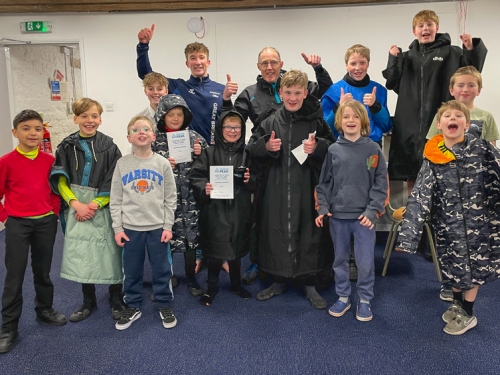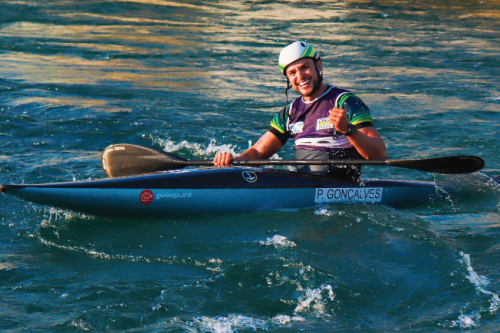
Turning in the wind efficiently – it’s all about listening to your kayak…
The Autumn is upon us and with that comes ‘storm season’, so for those still keen to get out on the sea there’s going to be time spent paddling in the wind over the coming months. For many the thought of sea kayaking in the wind, and certainly trying to turn your kayak in the wind, just brings memories of hard work, turns of a thousand strokes and the trusty sea kayak seeming to have a mind of its own that often is not wanting to do the same as the paddler! With a bit of understanding and practice the blood, sweat and tears of turning in the wind can be a thing of the past, but for this to happen we need to realise the kayak does have a mind of its own – we just need to listen to it!
I’m keen to introduce you to your kayak, help you understand it and listen to it; and from this work with it to become a little more efficient when turning in the wind. It is all about hearing and understanding what the kayak wants to do when in the wind, and then using that knowledge tactically to help it turn. With this as a starting point we can then add techniques to assist the kayak doing what it wants to do. Obviously, all kayaks and paddlers are different, so this is not about being prescriptive and suggesting there is ‘only one correct way’, but more about providing some concepts to support you evolving what works best for you and your kayak.

Is there a need for speed?
To start getting to know your kayak, pack it as you normally would for the majority of your paddling and go out on the water so you are side on to the wind. Do not engage the skeg or do any corrective strokes, just get a feel for what the kayak naturally wants to do and try the following:Sitting still – side on to the wind and not moving discover what your kayak wants to do; does it just drift downwind side on to the wind or does it have a tendency to blow bow downwind or stern downwind? Try placing and holding the paddle a blade depth in the water towards the bow and stern (on the upwind side to avoid tripping over it!) and see the effect it has; is this alone enough to start the bow/stern turning a bit more downwind?Paddling forwards & backwards – do this at a comfortable speed, side on to the wind with no corrective strokes, just let the kayak do what it wants to do. Does the bow turn upwind when going forwards and stern upwind when going backwards? Is the shape of turn similar for both or is backwards a tighter turn?Optimum speed to turn – if wanting to help the kayak turn experiment with the optimum speed to make this happen forwards and back. Every boat will have an optimum turning speed, you need to listen to yours and find out what it is!

Is there a need for trim?
We can adjust the trim in our kayak by simply moving our upper body forward or backwards a bit, the question to discover is how much does your kayak listen to this shift in body weight trim?
Body weight trim to turn – paddle at your newly discovered ‘optimum speed’ to turn forwards and backwards and experiment with moving your upper body weight. Does your kayak listen and if so can you use this trim to increase or decrease the turning effect?Packing trim – clearly how we pack our kayaks has a big effect on trim. An even weight distribution is a good start, but as you get to know your kayak you may purposely pack stern or bow heavy to help turning/tracking performance. When on expedition I always use my full water carrier as means to constantly adjust trim by moving it depending on wind and performance I am looking for.

Listening to and then assisting our kayaks to turn
Having experimented with the above you should now be really getting to know your kayak and be starting to understand the tactics for helping it turn in the wind. We can now consider these tactics and add some techniques (strokes) to help:Static turns – if we have space then add some speed to start the turn, paddling forwards to turn upwind or backwards to turn downwind. Think about adding strokes that anchor the bow or stern and assist the turn, remembering what happened when were sitting still and putting a paddle blade towards the bow or stern.
Upwind turns – think about paddling forward at your optimum speed with appropriate forward body trim as already discovered, the kayak will want to turn. Add turning strokes that can maintain that optimum speed, help the trim and anchor the bow a bit.
Downwind turns – think about decreasing the speed to aid the turn, adding some rear body trim and considering turning strokes that anchor the back of the kayak and slow the speed. If this stalls the kayak and you have not turned, then just paddle backwards at your optimum speed!

Increasing the efficiency
For more efficiency then there are still some things we can play with to help our kayaks turn, or indeed prevent them turning and help them track straight.
Skeg – this is often an underutilised part of the kayak that allows us to fine tune how much we want to ‘anchor’ the stern of the kayak and prevent it blowing downwind. It is not about it being on or off, neither is it a sign of incompetence if we need to deploy it; it is something to be understood and mastered to achieve ultimate efficiency! Think about raising it or dropping it to assist all the above turns, equally play with fine tuning it to get the kayak tracking perfectly across wind. If you don’t feel it is working then play with how the kayak is packed and adjust the trim.
Edge – we all know that the sea kayak comes to life when turning if an appropriate edge is used. As you feel comfortable in the conditions try adding this to the above for increased efficiency.
Timing – To bring all of the above together and work in harmony with the wind and waves around, then timing is the final piece of the jigsaw to play with. That could be the timing of when to start strokes or deploy skeg, or equally the timing on when to start a turn with regards the waves or gusts of wind that could assist the turn.

Remember it is not just about listening; it is hearing & understanding!
Hopefully by experimenting with the above you will now be more at one with your kayak. Just remember when wanting to turn in the wind to not only listen to what the kayak is telling you, but hear what it is saying in relation to the environment and look to understand what you can do to help - happy paddling!










